Collapse Analyses of Pre- and Low-Code Italian RC Building Types
Abstract
1. Introduction
2. Literature Review
3. Methodology
3.1. Selection of Building Types
3.2. Design and Modeling
3.3. Incremental Dynamic Analyses
4. Results
4.1. Inter-Storey Drift Ratio at Collapse
- IDR values decrease as the number of storeys increases for both GLD and ERD types. Specifically, the minimum mean values for GLD are approximately 3.5%, 2.8%, and 1.9% for 2s, 4s, and 6s types, respectively, while they become 4.4%, 2.9%, and 2.4% for ERD. To understand the observed trend, it is important to note that the collapse mechanism for each type generally involves the bottom storeys, as illustrated in Figure 8, which illustrates the IDR profiles related to the minimum values along the X and Y directions. Since cross-section dimensions of columns and the related reinforcement details do not change significantly across the storeys, the displacement capacity reduces with the number of storeys (i.e., as axial forces increase). This aspect can be better acknowledged in Table 1, where the plastic rotation values (at capping) for the columns of the first storey are reported for all types.
- The minimum IDR values among the two in-plane directions detected for ERD are higher compared to GLD types, with increments of about 25% for 2s and 6s and about 5% for 4s. A different trend is observed between the two in-plane directions. For GLD, the X direction exhibits lower IDR values compared to the Y direction, whereas the opposite is found for the ERD types, with notable differences between the X and Y directions. For this purpose, it is worth noting that, in GLD, the cross-section dimensions and reinforcements details of the columns are quite similar for both in-plane directions. Therefore, the greater lateral displacement capacity along the Y direction mainly depends on the contribution of stairs and infills (which have no openings along the Y direction). On the contrary, lateral forces considered for ERD types significantly increase the lateral displacement capacity of the frames along the X direction compared to those along the Y direction. Indeed, as previously described, the lateral resisting scheme of the considered prototypes has a greater number of frames along the X direction compared to those along the Y direction, which are placed only on the exterior sides. Furthermore, the columns’ response along the Y direction exhibits a greater number of brittle failures compared to the X direction. Finally, note that, according to the common practice of the period, the contribution of the staircase sub-structure is the same as in GLD, since it has been designed only for vertical loads.
- As for dispersion, the σln values associated with the minimum IDR range from 0.35 to 0.49 for GLD, while lower values (0.22–0.35) are observed for ERD. Although simple schemes have been adopted, the interior force analyses carried out for EDR types generally reduce the variability of the response at collapse with respect to GLD, whose structural members have mainly been designed by adopting the minimum requirements of codes.
4.2. Fragility Curves at Collapse
5. Conclusions
- Ground motion intensities at collapse evaluated for ERD types are generally higher than those for GLD, as expected, with larger differences for 4s and 6s types;
- In GLD, the Y direction is stronger than the X direction. On the contrary, in ERD types, lateral load design increases the lateral capacity of frames along the X direction more than along the Y direction, mainly due to the number of frames along the two in-plane directions, which affects the distribution of lateral loads, and the higher occurrence of brittle failures;
- IDR values at collapse decrease as the number of storeys increases, with ERD types exhibiting higher values compared to GLD ones. More specifically, the minimum mean IDR values for GLD are approximately 3.5%, 2.8%, and 1.9% for 2s, 4s, and 6s types, respectively, while for ERD types, the values are 4.4%, 2.9%, and 2.4%. The same trend previously described for ground motion intensities in the two in-plane directions is also found for IDR results.
- As for dispersion, the values range from 0.35 to 0.49 for GLD types, while lower values (0.22–0.35) are found for ERD.
- As expected, for all IMs, ERD types exhibit higher median values compared to GLD ones, with more significant differences observed for 4s and 6s types (in the range of about 20–80%). Lower differences are found for 2s types (in the range of about 5–10%).
- The median values for 2s are higher than those for 4s and 6s, which have similar values. The differences between 2s and 4–6s types are about 40% for GLD and 25% for ERD for all IMs, except for Sa(T1) and AI, which exhibit greater differences (in the range of about 43–66%).
- For GLD types, the median values in the X direction are always higher than those in the Y direction across all the considered IMs, whereas ERD types exhibit the opposite trend.
- The lowest dispersion values are found for HI (0.15–0.22) and Sa,avg (0.16–0.22), revealing greater efficiency compared to the other IMs such as Sa(T1) and AI, whose values are in the range 0.47–0.69 and 0.53–0.72, respectively.
- In general, the dispersion values slightly increase as the number of storeys increases without any significant differences between GLD and ERD types.
Funding
Data Availability Statement
Acknowledgments
Conflicts of Interest
Appendix A
| Signal | Mw | Repi [km] | VS30 [m/s] | PGA [g] | PGV [cm/s] | HI [m] | Sa (T1 = 0.25 s) [g] | Sa (T1 = 0.5 s) [g] | Sa (T1 = 0.75 s) [g] | Sa,avg [g] | AI [m/s] |
|---|---|---|---|---|---|---|---|---|---|---|---|
| #1 | 6.4 | 21.37 | na | 0.11 | 6.12 | 0.26 | 0.37 | 0.16 | 0.11 | 0.06 | 0.14 |
| #2 | 5.7 | 18.73 | 408 | 0.12 | 8.44 | 0.23 | 0.32 | 0.10 | 0.05 | 0.06 | 0.08 |
| #3 | 5.6 | 5.9 | 378 | 0.13 | 10.40 | 0.29 | 0.28 | 0.21 | 0.12 | 0.07 | 0.12 |
| #4 | 5.9 | 27.77 | 363 | 0.10 | 4.46 | 0.22 | 0.12 | 0.08 | 0.07 | 0.05 | 0.11 |
| #5 | 6.9 | 23.77 | 1149 | 0.06 | 5.06 | 0.20 | 0.13 | 0.11 | 0.06 | 0.05 | 0.06 |
| #6 | 6 | 17.53 | na | 0.12 | 9.60 | 0.29 | 0.26 | 0.18 | 0.11 | 0.07 | 0.10 |
| #7 | 5.6 | 10.33 | 626 | 0.14 | 6.65 | 0.22 | 0.30 | 0.19 | 0.08 | 0.05 | 0.10 |
| #8 | 5.6 | 9.35 | 717 | 0.08 | 4.74 | 0.20 | 0.20 | 0.13 | 0.07 | 0.05 | 0.07 |
| #9 | 5.5 | 15.81 | 452 | 0.09 | 5.60 | 0.17 | 0.27 | 0.09 | 0.05 | 0.04 | 0.07 |
| #10 | 6.5 | 20.1 | na | 0.09 | 5.84 | 0.17 | 0.08 | 0.07 | 0.05 | 0.04 | 0.09 |
| #11 | 6.4 | 20.83 | 852 | 0.10 | 9.09 | 0.28 | 0.21 | 0.27 | 0.12 | 0.07 | 0.09 |
| #12 | 5.4 | 16.16 | 717 | 0.05 | 4.14 | 0.19 | 0.07 | 0.07 | 0.07 | 0.04 | 0.02 |
| #13 | 6.4 | 30 | na | 0.12 | 8.39 | 0.32 | 0.33 | 0.21 | 0.08 | 0.08 | 0.14 |
| #14 | 5.7 | 25.39 | 409 | 0.07 | 4.42 | 0.16 | 0.13 | 0.13 | 0.08 | 0.04 | 0.04 |
| #15 | 5.9 | 10.04 | 901 | 0.13 | 6.34 | 0.18 | 0.27 | 0.11 | 0.11 | 0.04 | 0.16 |
| #16 | 5.6 | 25.24 | 412 | 0.12 | 4.20 | 0.19 | 0.31 | 0.06 | 0.05 | 0.05 | 0.08 |
| #17 | 6.1 | 29.53 | 403 | 0.11 | 4.24 | 0.16 | 0.24 | 0.10 | 0.11 | 0.04 | 0.14 |
| #18 | 5 | 7.84 | 529 | 0.10 | 5.54 | 0.17 | 0.23 | 0.15 | 0.08 | 0.04 | 0.05 |
| #19 | 5.9 | 23.85 | 601 | 0.08 | 6.73 | 0.16 | 0.13 | 0.13 | 0.09 | 0.04 | 0.05 |
| #20 | 5.4 | 12.29 | 685 | 0.07 | 5.17 | 0.17 | 0.13 | 0.12 | 0.10 | 0.04 | 0.03 |
Appendix B. Derivation of Fragility Curves from IDA Results
Appendix C
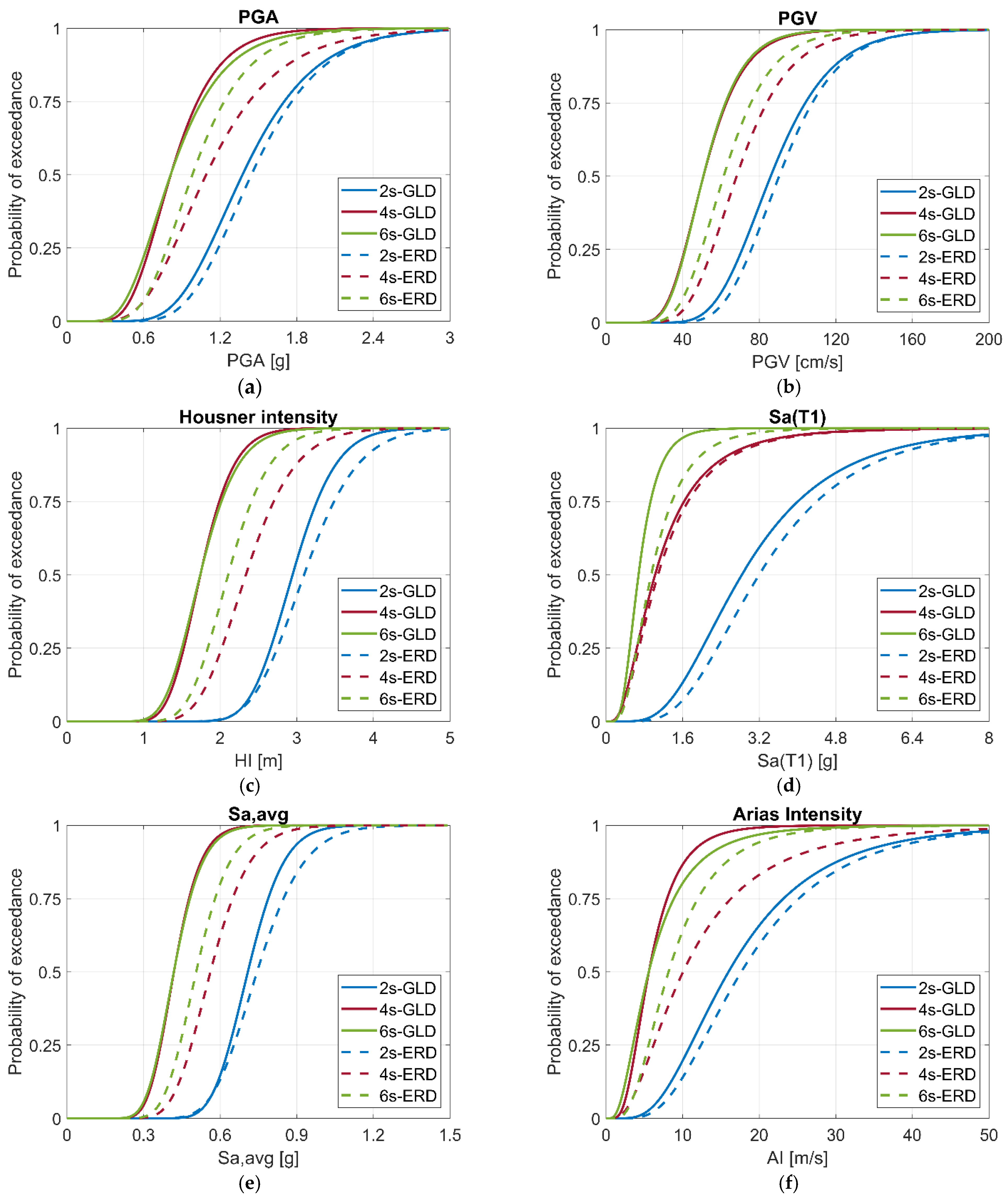
References
- Villaverde, R. Methods to assess the seismic collapse capacity of building structures: State of the art. J. Struct. Eng. 2007, 133, 57–66. [Google Scholar] [CrossRef]
- Adam, C.; Ibarra, L.F. Seismic Collapse Assessment. In Encyclopedia of Earthquake Engineering; Beer, M., Kougioumtzoglou, I., Patelli, E., Au, I.K., Eds.; Springer: Berlin/Heidelberg, Germany, 2014. [Google Scholar] [CrossRef]
- Lignos, D.; Krawinkler, H. Sidesway Collapse of Deteriorating Structural Systems Under Seismic Excitations; Report No. 177/2012; The John A. Blume Earthquake Engineering Center, Department of Civil and Environmental Engineering, Stanford University: Stanford, CA, USA, 2012. [Google Scholar]
- Galanis, P.H.; Moehle, J.P. Development of collapse indicators for risk assessment of older-type reinforced concrete buildings. Earthq. Spectra 2015, 31, 1991–2006. [Google Scholar] [CrossRef]
- Del Gaudio, C.; Ricci, P.; Verderame, G.M.; Manfredi, G. Urban-scale seismic fragility assessment of RC buildings subjected to L’Aquila earthquake. Soil. Dyn. Earthq. Eng. 2017, 96, 49–63. [Google Scholar] [CrossRef]
- Gaetani d’Aragona, M.; Polese, M.; Prota, A. Seismic fragility curves for infilled RC building classes considering multiple sources of uncertainty. Eng. Struct. 2024, 321, 118888. [Google Scholar] [CrossRef]
- Terrenzi, M.; Spacone, E.; Camata, G. Collapse limit state definition for seismic assessment of code-conforming RC buildings. Int. J. Adv. Struct. Eng. 2018, 10, 325–337. [Google Scholar] [CrossRef]
- Federal Emergency Management Agency. Hazus Earthquake Model-Technical manual Hazus 6.1.; Department of Homeland Security, Federal Emergency Management Agency, Mitigation Division: Washington, DC, USA, 2024.
- Celik, O.C.; Ellingwood, B.R. Seismic fragilities for non-ductile reinforced concrete frames—Role of aleatoric and epistemic uncertainties. Struct. Saf. 2010, 32, 1–12. [Google Scholar] [CrossRef]
- Erberik, M.A. Fragility-based assessment of typical mid-rise and low-rise RC buildings in Turkey. Eng. Struct. 2008, 30, 1360–1374. [Google Scholar] [CrossRef]
- Ghobarah, A. On drift limits associated with different damage levels. In Proceedings of the International Workshop on Performance-Based Seismic Design, Bled, Slovenia, 28 June–1 July 2004. [Google Scholar]
- Rossetto, T.; Elnashai, A. Derivation of vulnerability functions for European-type RC structures based on observational data. Eng. Struct. 2003, 25, 1241–1263. [Google Scholar] [CrossRef]
- Kappos, A.J.; Panagopoulos, G. Fragility curves for R/C buildings in Greece. Struct. Infrastruct. Eng. 2010, 6, 39–53. [Google Scholar] [CrossRef]
- Ricci, P.; Manfredi, V.; Noto, F.; Terrenzi, M.; Petrone, C.; Celano, F.; De Risi, M.T.; Camata, G.; Franchin, P.; Magliulo, G.; et al. Modeling and seismic response analysis of Italian code-conforming reinforced concrete buildings. J. Earthq. Eng. 2018, 22 (Suppl. S2), 105–139. [Google Scholar] [CrossRef]
- Vamvatsikos, D.; Cornell, C.A. Incremental dynamic analysis. Earthq. Eng. Struct. Dyn. 2002, 31, 491–514. [Google Scholar] [CrossRef]
- Baker, J.W.; Cornell, C.A. Spectral shape, epsilon and record selection. Earthq. Eng. Struct. Dyn. 2006, 35, 1077–1095. [Google Scholar] [CrossRef]
- Krawinkler, H.; Lignos, D.G. How to Predict the Probability of Collapse of Non-Ductile Building Structures. In Seismic Risk Assessment and Retrofitting. Geotechnical, Geological and Earthquake Engineering; Ilki, A., Karadogan, F., Pala, S., Yuksel, E., Eds.; Springer: Dordrecht, The Netherlands, 2009. [Google Scholar]
- Haselton, C.B.; Deierlein, G.G. Assessing Seismic Collapse Safety of Modern Reinforced Concrete Moment Frame Buidings; Report n. 156 February 2007; The John A. Blume Earthquake Engineering Centre, Standford University: Stanford, CA, USA, 2007. [Google Scholar]
- Liel, A.B.; Haselton, C.B.; Deierlein, G.G. Seismic Collapse Safety of Reinforced Concrete Buildings. II: Comparative Assessment of Nonductile and Ductile Moment Frames. J. Struct. Eng. 2011, 137, 492–502. [Google Scholar] [CrossRef]
- Miano, A.; Jalayer, F.; Ebrahimian, H.; Prota, A. Cloud to IDA: Efficient fragility assessment with limited scaling. Earthq. Engng Struct. Dyn. 2018, 47, 1124–1147. [Google Scholar] [CrossRef]
- Ibarra, L.F.; Medina, R.A.; Krawinkler, H. Hysteretic models that incorporate strength and stiffness deterioration. Earthq. Eng. Struct. Dyn. 2005, 34, 489–1511. [Google Scholar] [CrossRef]
- Goulet, C.A.; Haselton, C.B.; Mitrani-Reiser, J.; Beck, J.L.; Deierlein, G.G.; Porter, K.A.; Stewart, J.P. Evaluation of the seismic performance of a code-conforming reinforced-concrete frame building—From seismic hazard to collapse safety and economic losses. Earthq. Engng Struct. Dyn. 2007, 36, 1973–1997. [Google Scholar] [CrossRef]
- Haselton, C.B.; Baker, J.W. Ground Motion Intensity Measures for Collapse Capacity Prediction: Choice of Optimal Spectral Period and Effect of Spectral Shape. In Proceedings of the 8th National Conference on Earthquake Engineering, San Francisco, CA, USA, 18–22 April 2006. [Google Scholar]
- Zhou, J.; Zhang, Z.; Williams, T.; Kunnath, S.K. Challenges in Evaluating Seismic Collapse Risk for RC Buildings. Int. J. Concr. Struct. Mater. 2021, 15, 27. [Google Scholar] [CrossRef]
- Shome, N.; Cornell, C.A. Probabilistic Seismic Demand Analysis of Nonlinear Structures; Report No. RMS-35; RMS Program, Stanford University: Stanford, CA, USA, 1999. [Google Scholar]
- Kiani, J.; Camp, C.; Pezeshk, S. On the number of required response history analyses. Bull. Earthq. Eng. 2018, 16, 5195–5226. [Google Scholar] [CrossRef]
- Sattar, S.; Liel, A.B. Seismic Performance of Nonductile Reinforced Concrete Frames with Masonry Infill Walls—II: Collapse Assessment. Earthq. Spectra 2016, 32, 819–842. [Google Scholar] [CrossRef]
- Iervolino, I.; Baraschino, R.; Spillatura, A. Evolution of seismic reliability of code-conforming Italian buildings. J. Earthq. Eng. 2023, 27, 1740–1768. [Google Scholar] [CrossRef]
- Pavel, F. Collapse Assessment for Code-Conforming Reinforced Concrete Frame Structures in Romania. Front. Built Environ. 2018, 4, 50. [Google Scholar] [CrossRef]
- Di Domenico, M.; De Risi, M.T.; Manfredi, V.; Terrenzi, M.; Camata, G.; Mollaioli, F.; Noto, F.; Ricci, P.; Franchin, P.; Masi, A.; et al. Modelling and seismic response analysis of Italian pre-code and low-code reinforced concrete buildings. Part II: Infilled Frames. J. Earthq. Eng. 2022, 27, 1534–1564. [Google Scholar] [CrossRef]
- Shokrabadi, M.; Banazadeh, M.; Shokrabadi, M.; Mellati, A. Assessment of seismic risks in code conforming reinforced concrete Frames. Eng. Struct. 2015, 98, 14–28. [Google Scholar] [CrossRef]
- Noh, N.M.; Tesfamariam, S. Seismic Collapse Risk Assessment of Code-Conforming RC Moment Resisting Frame Buildings Designed with 2014 Canadian Standard Association Standard A23.3. Front. Built Environ. 2018, 4, 53. [Google Scholar] [CrossRef]
- De Risi, M.T.; Di Domenico, M.; Manfredi, V.; Terrenzi, M.; Camata, G.; Mollaioli, F.; Noto, F.; Ricci, P.; Franchin, P.; Masi, A.; et al. Modelling and seismic response analysis of Italian pre-code and low-code reinforced concrete buildings. Part I: Bare Frames. J. Earthq. Eng. 2022, 27, 1482–1513. [Google Scholar] [CrossRef]
- Manfredi, V.; Masi, A.; Nicodemo, G.; Digrisolo, A. Seismic fragility curves for the Italian RC residential buildings based on non linear dynamic analyses. Bull. Earthq. Eng. 2023, 21, 2173–2214. [Google Scholar] [CrossRef]
- Masi, A.; Lagomarsino, S.; Dolce, M.; Manfredi, V.; Ottonelli, D. Towards the updated Italian seismic risk assessment: Exposure and vulnerability modelling. Bull. Earthq. Eng. 2021, 19, 3253–3286. [Google Scholar] [CrossRef]
- Italian National Institute of Statistics, ISTAT. Website and Data Warehouse 2011. Available online: https://www.istat.it/ (accessed on 11 March 2025). (In Italian)
- Law n. 1086, 5 November 1971. Norme per la disciplina delle opere di conglomerato cementizio armato, normale e precompresso ed a struttura metallica. Official Journal n. 321, 21 December 1971. (In Italian)
- Law n. 64, 2 February 1974. Provvedimenti per le costruzioni con particolari prescrizioni per le zone sismiche. Official Journal n. 76, 21 March 1974. (In Italian)
- Royal Decree n. 2229, 16 November 1939. Norme per l’accettazione dei leganti idraulici. Official Journal n.92, 18 April 1940. (In Italian)
- Law n. 1684 25 November 1962. Provvedimenti per l’edilizia, con particolari prescrizioni per le zone sismiche. Official Journal n. 326, 25 November 1962. (In Italian)
- Royal Law Decree n. 640, 25 March 1935. Nuovo testo delle norme tecniche di edilizia con speciali prescrizioni per le localita colpite dai terremoti. Official Journal n. 120, 22 May 1935. (In Italian)
- Ordinance of the President of the Council of Ministers (OPCM) 20 March 2003, n.3274, Official Journal n. 72, 8 May 2003. (In Italian)
- Manfredi, V.; Masi, A. Seismic Strengthening and Energy Efficiency: Towards an Integrated Approach for the Rehabilitation of Existing RC Buildings. Buildings 2018, 8, 36. [Google Scholar] [CrossRef]
- Masi, A. Seismic vulnerability assessment of gravity load designed R/C frames. Bull. Earthq. Eng. 2003, 1, 371–395. [Google Scholar] [CrossRef]
- Ministerial Decree 30 May 1972. Norme tecniche alle quali devono uniformarsi le costruzioni in conglomerato cementizio, normale e precompresso ed a struttura metallica. Official Journal n. 190 22 July 1972. (In Italian)
- McKenna, F. OpenSees: A framework for earthquake engineering simulation. Comput. Sci. Eng. 2011, 13, 58–66. [Google Scholar] [CrossRef]
- Haselton, C.B.; Liel, A.B.; Lange, S.T.; Deierlein, G.G. Beam-Column Element Model Calibrated for Predicting Flexural Response Leading to Global Collapse of RC Frame Buildings; PEER Report No. 2007/03; University of California: Berkeley, CA, USA, 2008. [Google Scholar]
- Sezen, H.; Moehle, J.P. Shear strength model for lightly reinforced concrete columns. J. Struct. Eng. 2004, 130, 1692–1703. [Google Scholar] [CrossRef]
- Decanini, L.D.; Fantin, G.E. Modelos simplificados de la mampostería incluidas en porticos. Características de rigidez y resistencia lateral en estado límite. In Proceedings of the Actas de las VI Jornadas Argentinas de Ingenieria Estructural, Buenos Aires, Argentina, 1–3 October 1986; Volume 2, pp. 817–836. [Google Scholar]
- Ricci, P.; Manfredi, V.; Noto, F.; Terrenzi, M.; De Risi, M.T.; Di Domenico, M.; Camata, G.; Franchin, P.; Masi, A.; Mollaioli, F.; et al. RINTC-e: Towards seismic risk assessment of existing residential reinforced concrete buildings in Italy, In Proceedings of the COMPDYN 2019-7th International Conference on Computational Methods in Structural Dynamics and Earthquake Engineering, Crete, Greece, 24–26 June 2019.
- Masi, A.; Digrisolo, A.; Santarsiero, G. Analysis of a Large Database of Concrete Core Tests with Emphasis on Within-Structure Variability. Materials 2019, 12, 1985. [Google Scholar] [CrossRef] [PubMed]
- Verderame, G.M.; Ricci, P.; Esposito, M.; Manfredi, G. STIL v1.0—Software per la caratterizzazione delle proprietà meccaniche degli acciai da c.a. tra il 1950 e il 2000. ReLUIS, Naples, Italy. Available online: http://www.reluis.it/ (accessed on 10 February 2025).
- Calvi, G.M.; Bolognini, D. Seismic response of reinforced concrete frames infilled with weakly reinforced masonry panels. J. Earthq. Eng. 2001, 5, 153–185. [Google Scholar] [CrossRef]
- Jalayer, F.; Cornell, C.A. Alternative non-linear demand estimation methods for probability-based seismic assessments. Earthq. Eng. Struct. Dyn. 2009, 38, 951–972. [Google Scholar] [CrossRef]
- Cornell, C.A.; Jalayer, F.; Hamburger, R.O.; Foutch, D.A. Probabilistic basis for 2000 SAC Federal Emergency Management Agency steel moment frame guidelines. J. Struct. Eng. (ASCE) 2002, 128, 526–533. [Google Scholar] [CrossRef]
- Zacharenaki, A.; Fragiadakis, M.; Assimaki, D.; Papadrakakis, M. Bias assessment in Incremental Dynamic Analysis due to record scaling. Soil. Dyn. Earthq. Eng. 2014, 67, 158–168. [Google Scholar] [CrossRef]
- Vamvatsikos, D.; Cornell, C.A. Applied incremental dynamic analysis. Earthq. Spectra 2004, 20, 523–553. [Google Scholar] [CrossRef]
- Smerzini, C.; Galasso, C.; Iervolino, I.; Paolucci, R. Ground motion record selection based on broadband spectral compatibility. Earthq. Spectra 2014, 30, 1427–1448. [Google Scholar] [CrossRef]
- Manfredi, V.; Masi, A.; Özcebe, A.G.; Paolucci, R.; Smerzini, C. Selection and spectral matching of recorded ground motions for seismic fragility analyses. Bull. Earthq. Eng. 2022, 20, 4961–4987. [Google Scholar] [CrossRef]
- Ministrial Decree 17 January 2018, NTC 2018. Aggiornamento delle “Norme Tecniche per le Costruzioni”. Official Journal n. 42, 20 February 2018. (In Italian)
- Kazantzi, A.K.; Vamvatsikos, D. Intensity measure selection for vulnerability studies of building classes. Earthq. Eng. Struct. Dyn. 2015, 44, 2677–2694. [Google Scholar] [CrossRef]
- Porter, K.; Kennedy, R.; Bachman, R. Creating Fragility Functions for Performance-Based Earthquake Engineering. Earthq. Spectra 2007, 23, 471–489. [Google Scholar] [CrossRef]
- Baker, J.W. Efficient analytical fragility function fitting using dynamic structural analysis. Earthq. Spectra 2015, 31, 579–599. [Google Scholar] [CrossRef]
- O’Reilly, G.J. Limitations of Sa(T1) as an intensity measure when assessing non-ductile infilled RC frame structures. Bull. Earthq. Eng. 2021, 19, 2389–2417. [Google Scholar] [CrossRef]
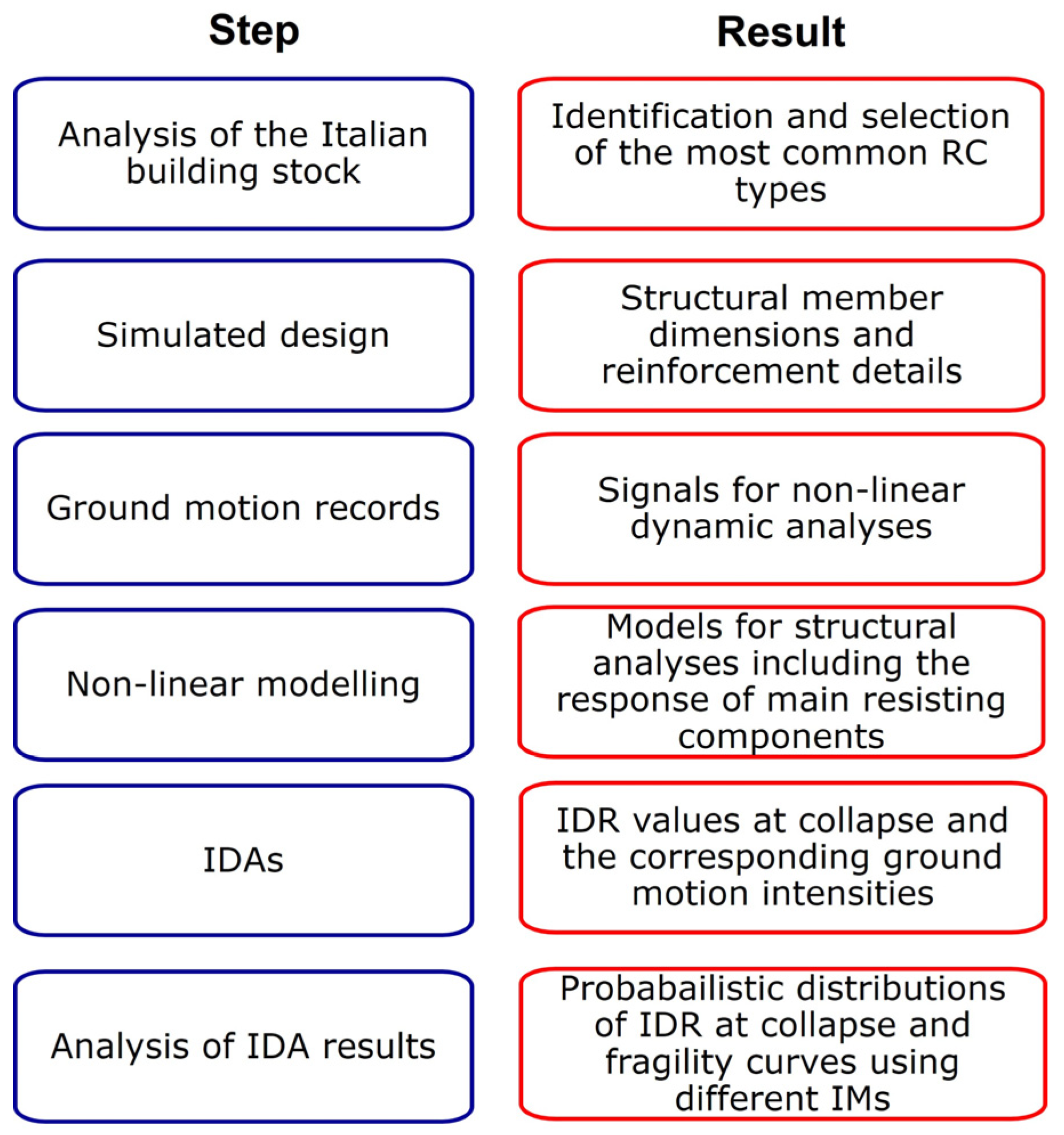
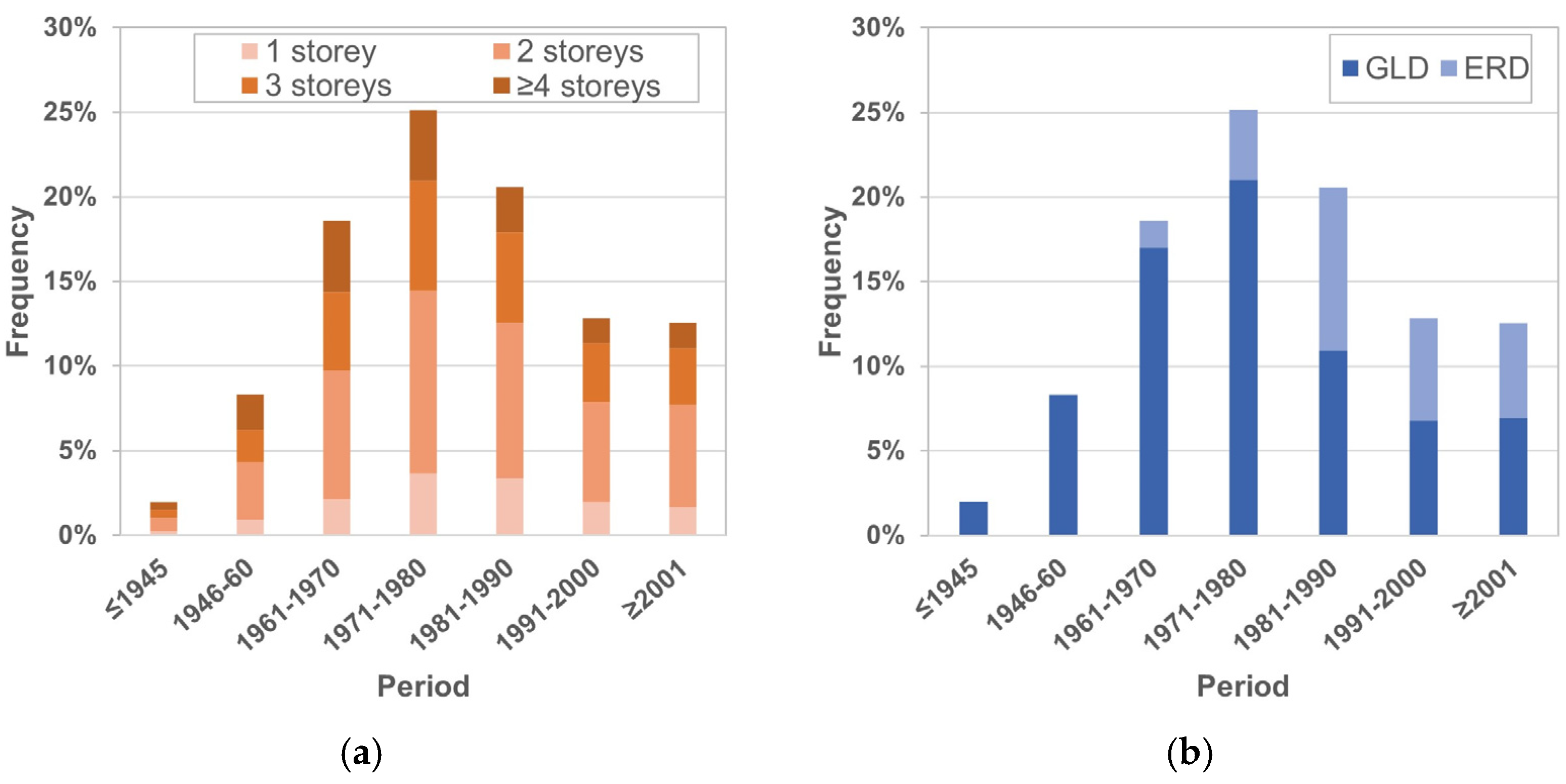
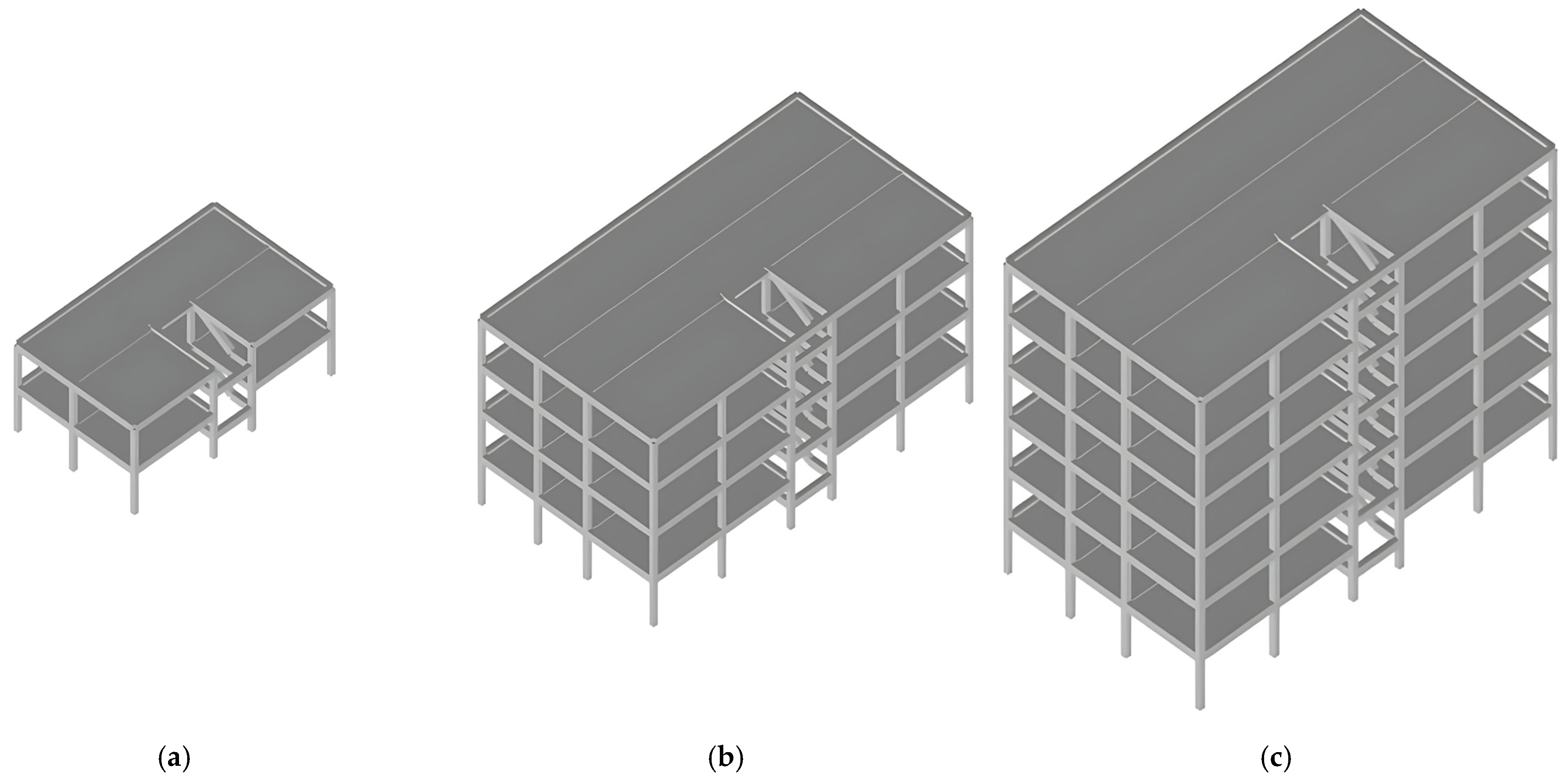
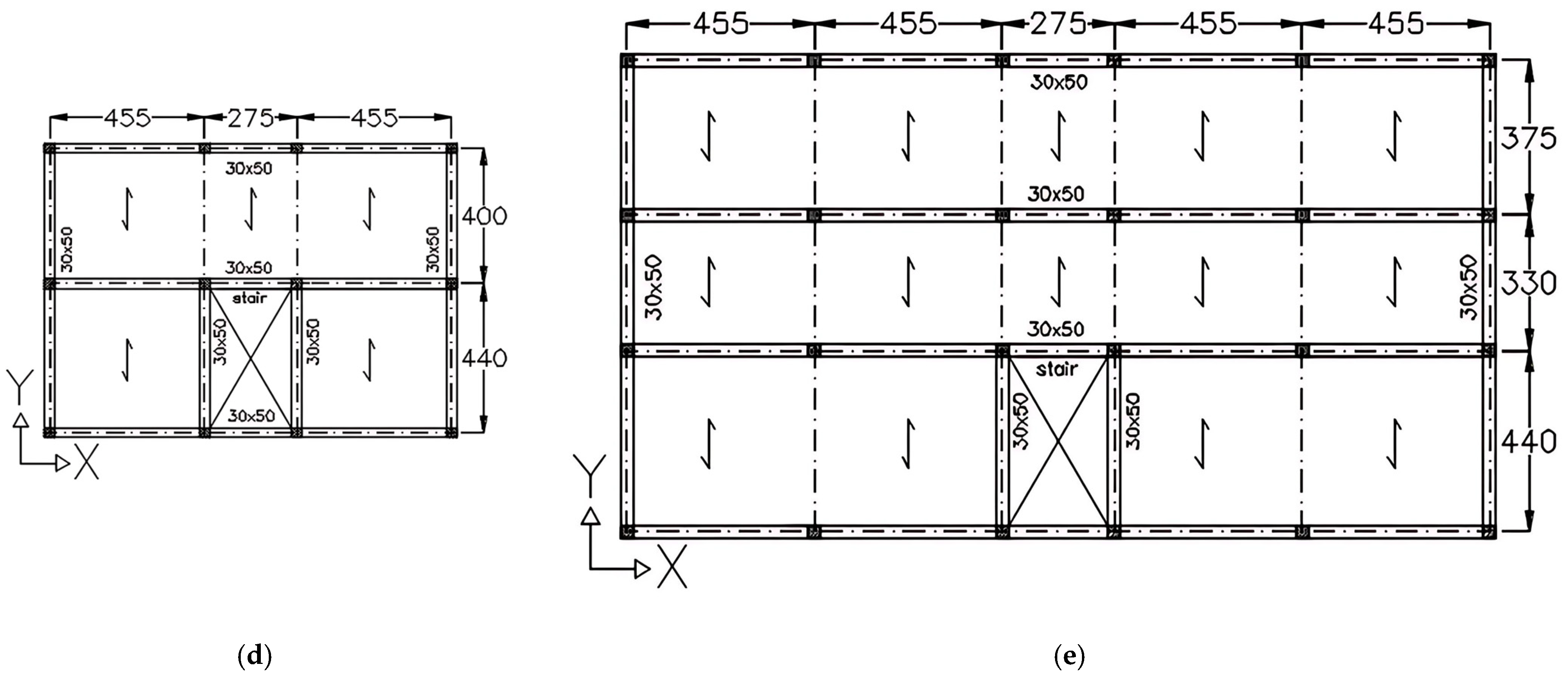

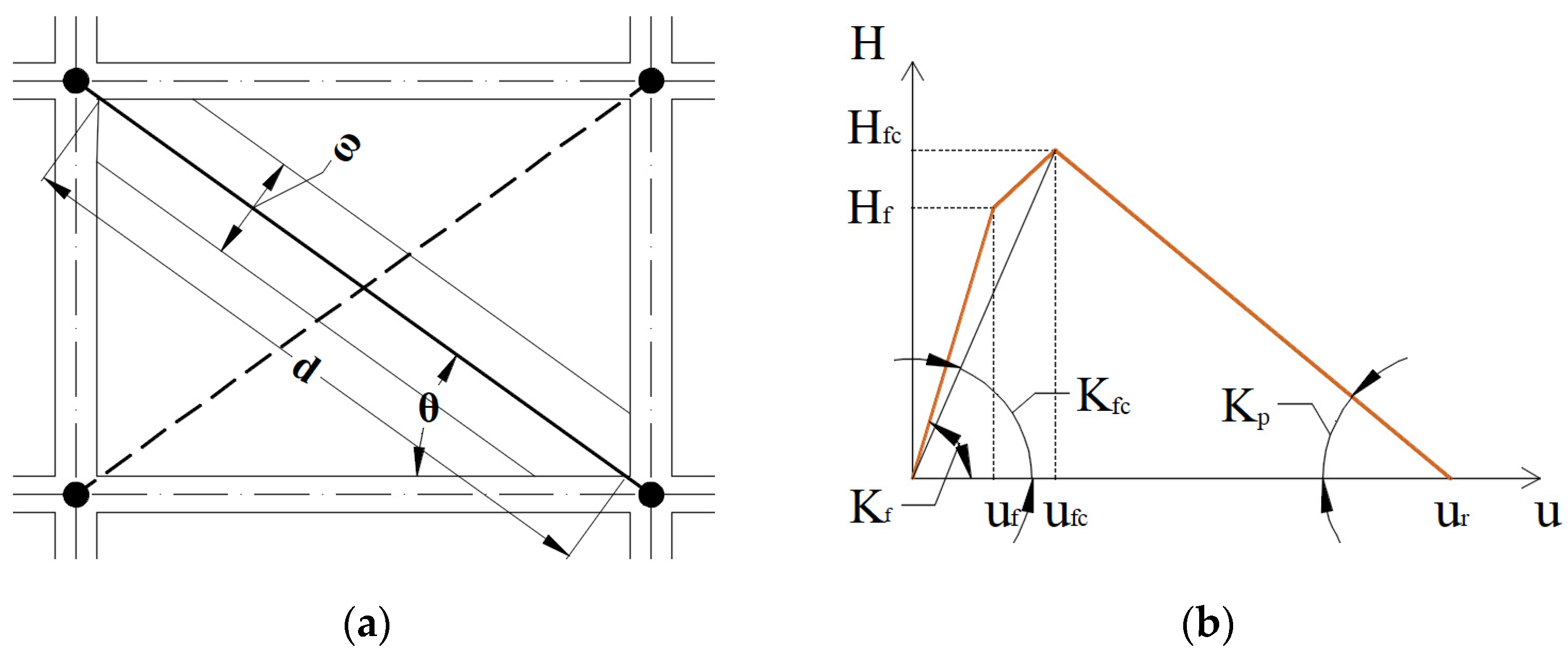
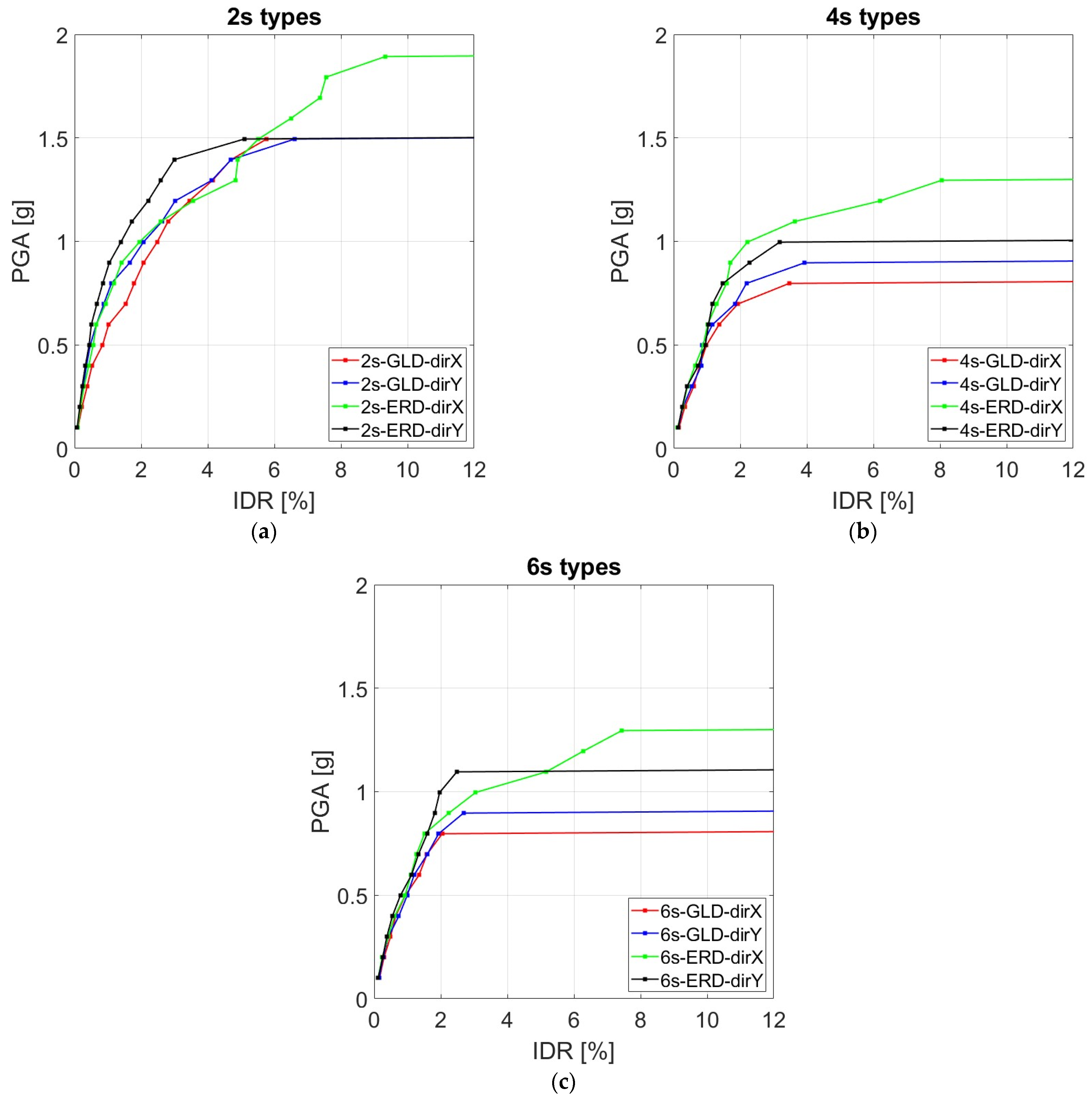

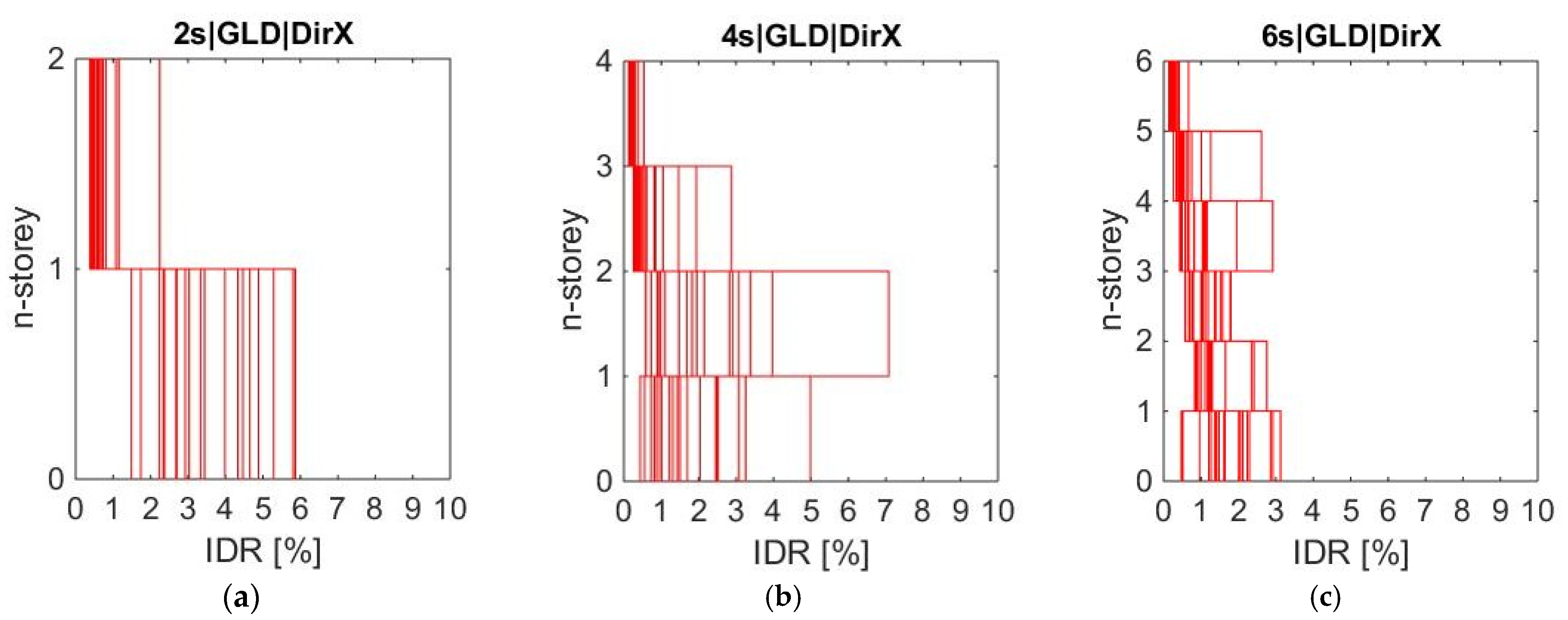
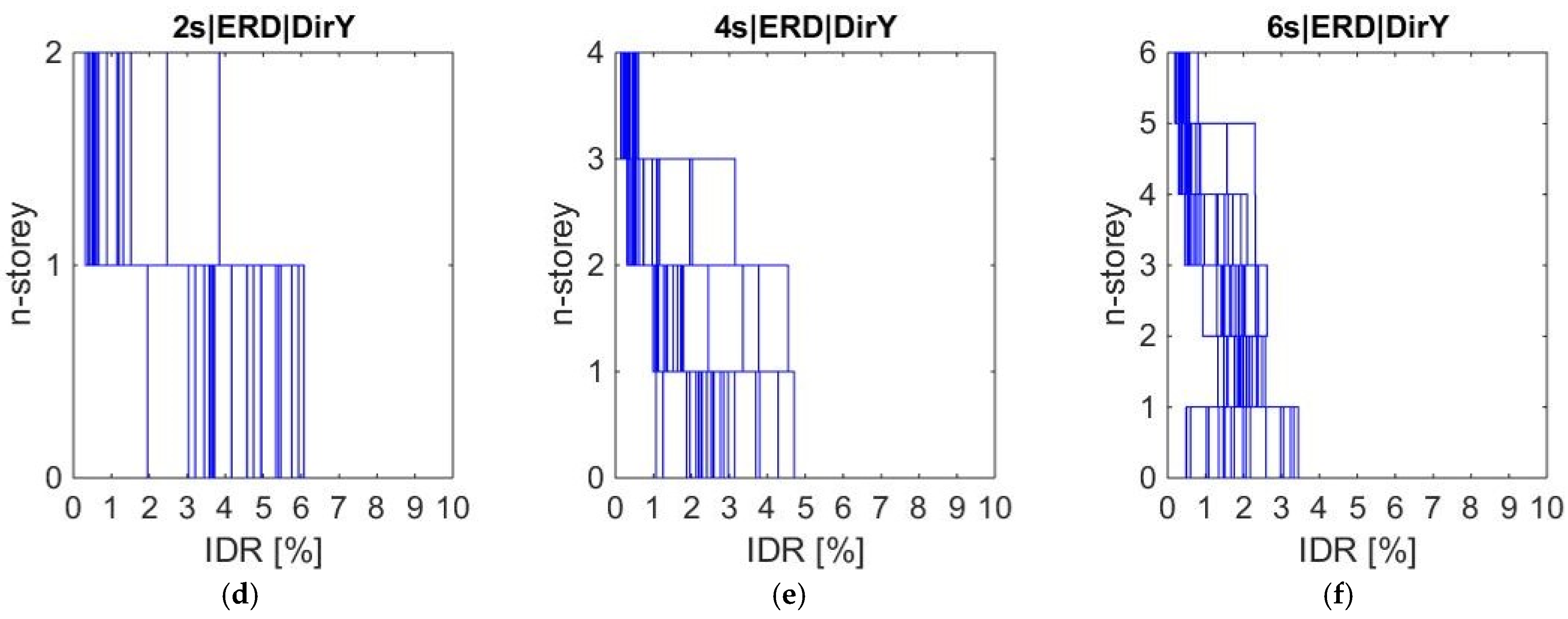
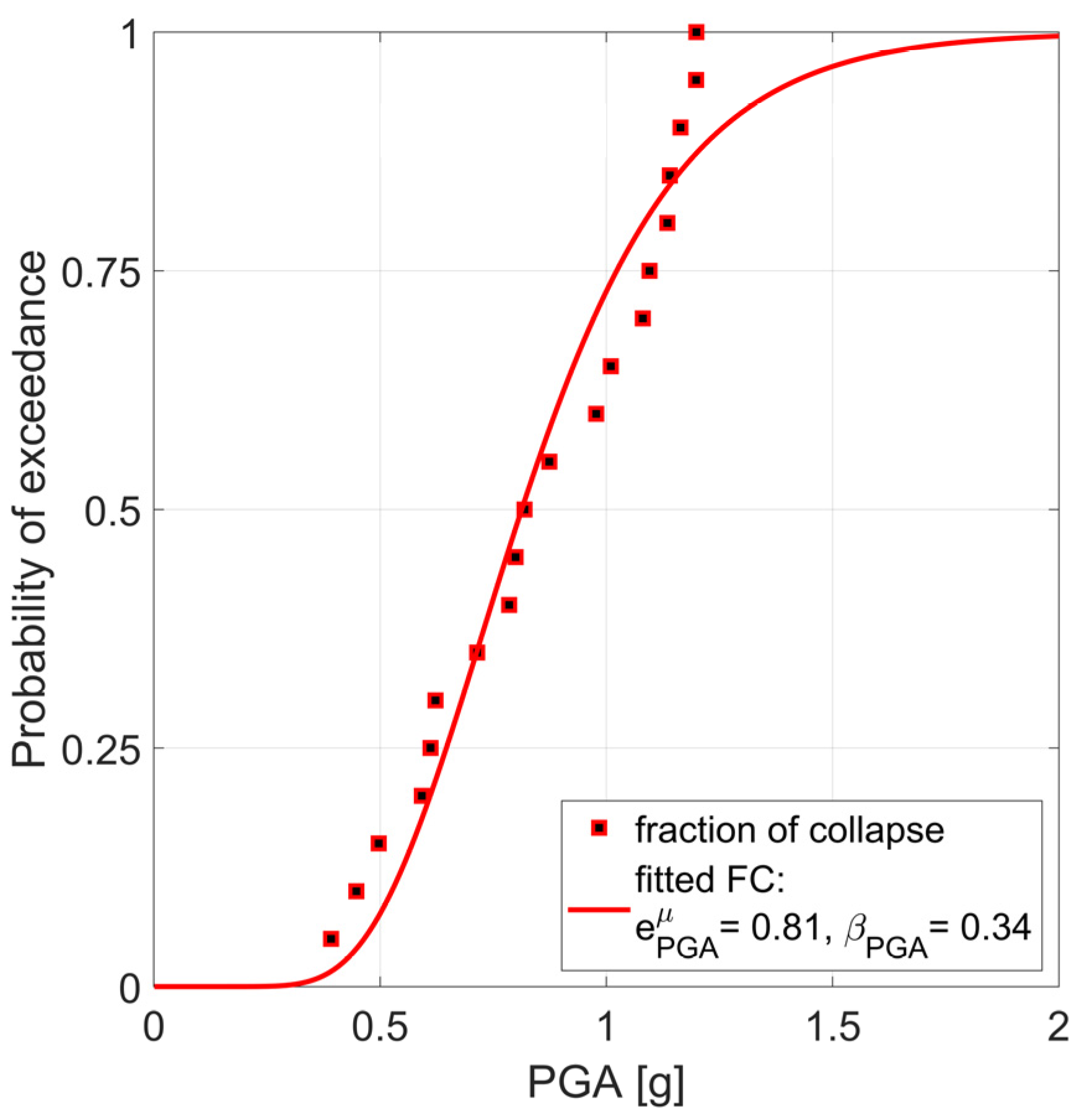
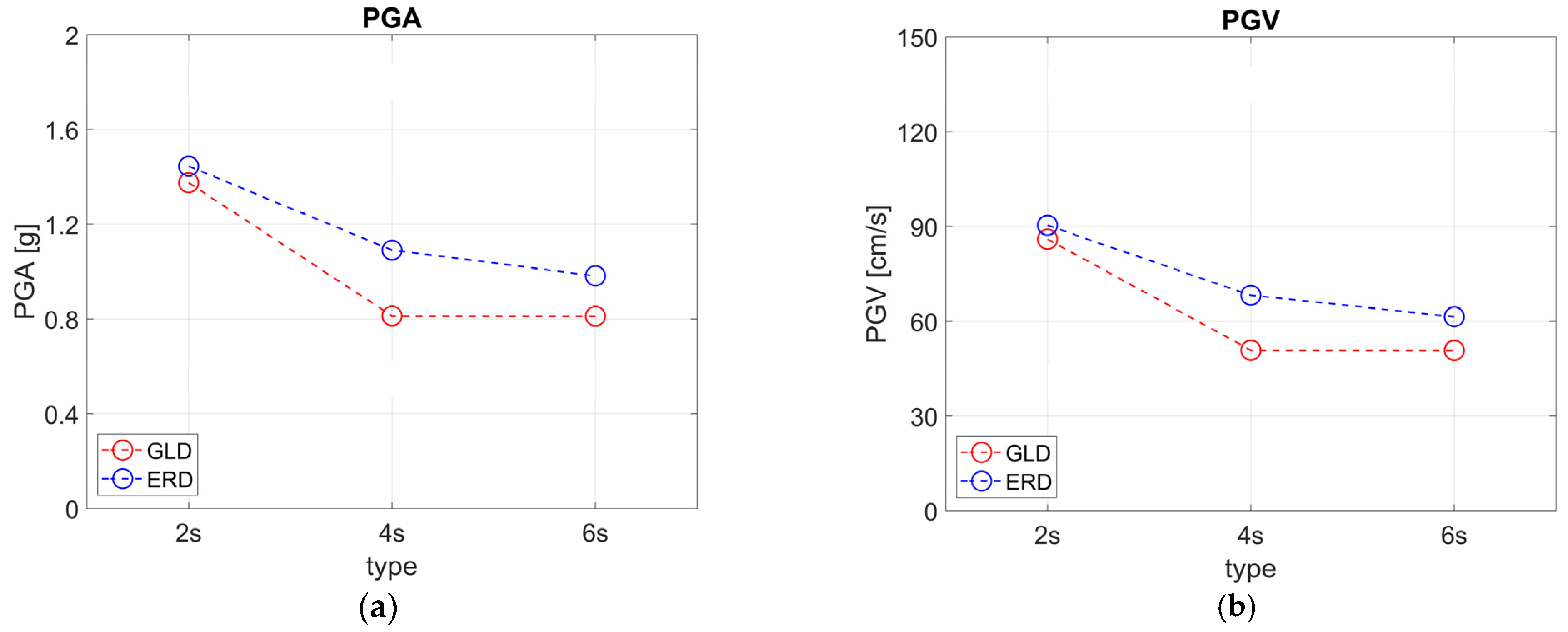
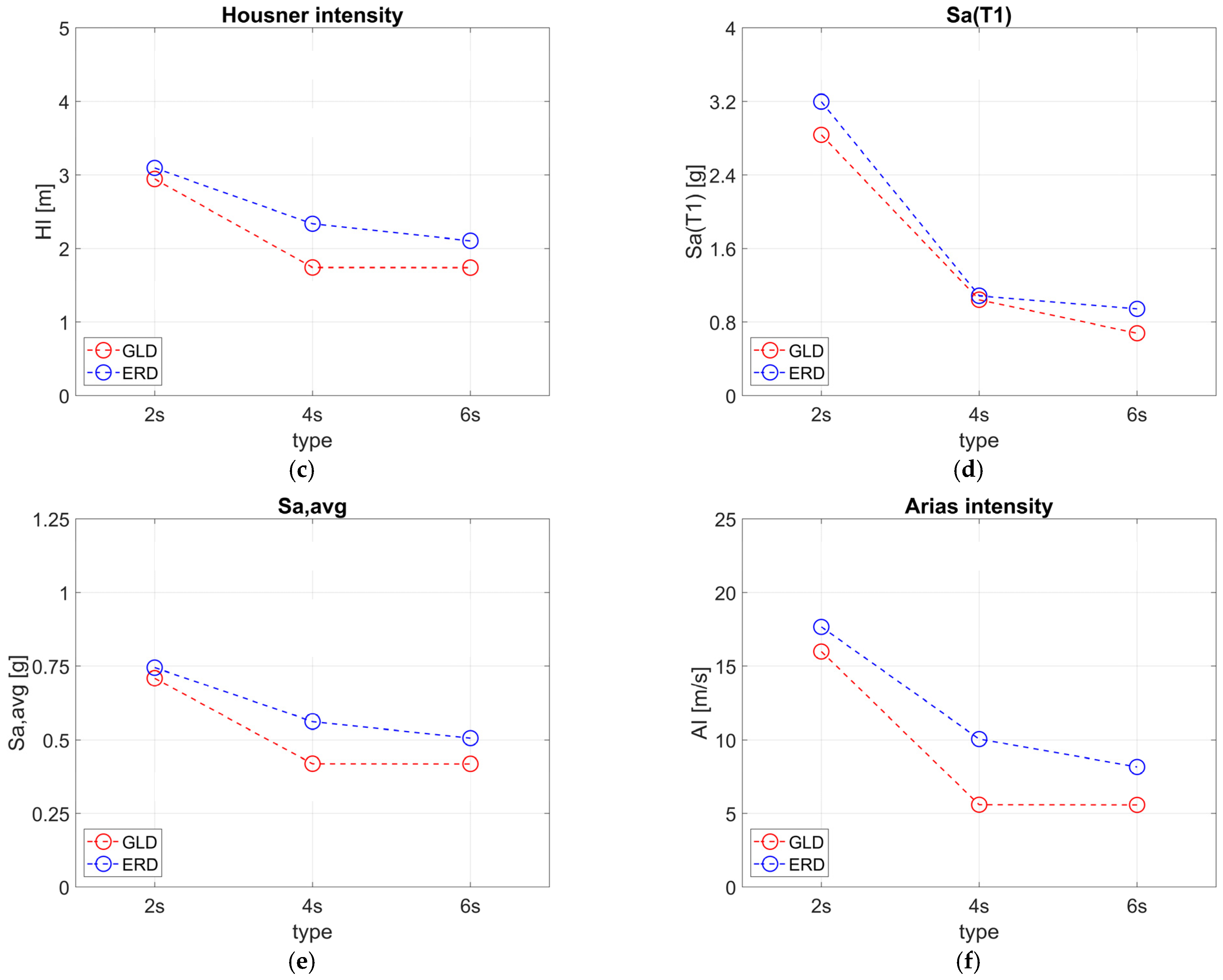
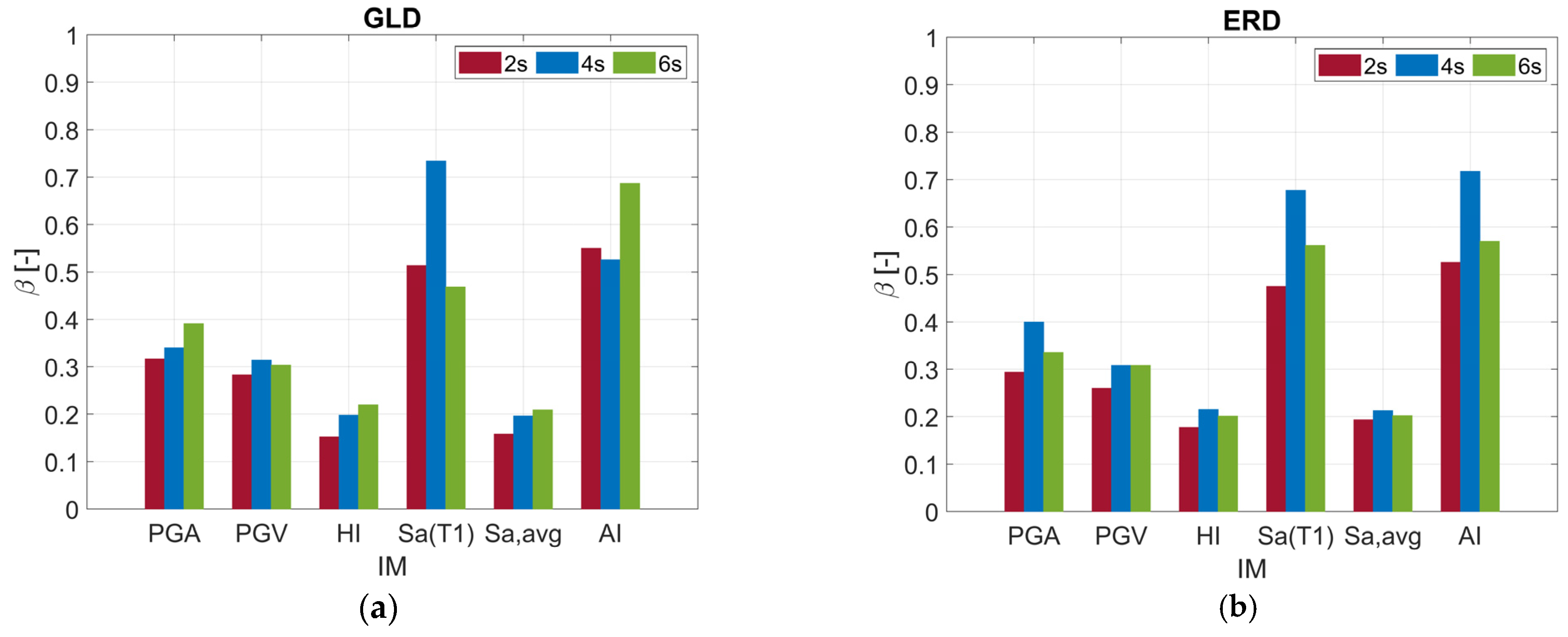
| Type | ρl_X [%] | ρl_Y [%] | ρw_Y [%] | ρw_Y [%] | Mcap_X [kNm] | Mcap_Y [kNm] | θcap_X [-] | θcap_Y [-] | T1 [s] |
|---|---|---|---|---|---|---|---|---|---|
| 2s-GLD | 0.28 | 0.28 | 0.11 | 0.11 | 68.2 | 68.2 | 0.0235 | 0.0245 | 0.25 |
| 4s-GLD | 0.25 | 0.29 | 0.11 | 0.10 | 101.2 | 88.3 | 0.0181 | 0.0131 | 0.49 |
| 6s-GLD | 0.24 | 0.31 | 0.10 | 0.08 | 145.1 | 117.0 | 0.0106 | 0.0100 | 0.77 |
| 2s-ERD | 0.50 | 0.31 | 0.09 | 0.09 | 114.3 | 102.2 | 0.0113 | 0.0135 | 0.23 |
| 4s-ERD | 0.56 | 0.30 | 0.10 | 0.08 | 216.4 | 108.4 | 0.0165 | 0.0121 | 0.49 |
| 6s-ERD | 0.53 | 0.27 | 0.07 | 0.07 | 320.3 | 195.2 | 0.0082 | 0.0082 | 0.70 |
| GLD | ERD | ||||||
|---|---|---|---|---|---|---|---|
| 2s | 4s | 6s | 2s | 4s | 6s | ||
| IDR dirX | µ (16th–84th) [%] | 3.52 (2.19–4.82) | 2.76 (1.50–3.99) | 1.93 (1.28–2.57) | 7.38 (5.02–9.72) | 5.37 (2.87–7.80) | 6.31 (3.18–9.33) |
| σln | 0.40 | 0.49 | 0.35 | 0.33 | 0.50 | 0.54 | |
| IDR dirY | µ (16th–84th) [%] | 4.81 (3.03–6.57) | 3.56 (2.29–4.82) | 2.53 (1.82–3.24) | 4.43 (3.22–5.64) | 2.89 (1.93–3.84) | 2.40 (1.87–2.93) |
| σln | 0.39 | 0.37 | 0.29 | 0.28 | 0.35 | 0.22 | |
| Type | In-Plane Direction | PGA | PGV | HI | Sa(T1) | Sa,avg | AI | ||||||
|---|---|---|---|---|---|---|---|---|---|---|---|---|---|
| eµ [g] | β [-] | eµ [cm/s] | β [-] | eµ [m] | β [-] | eµ [g] | β [-] | eµ [g] | β [-] | eµ [m/s] | β [-] | ||
| 2s-GLD | Dir-X | 1.38 | 0.32 | 86.01 | 0.28 | 2.95 | 0.15 | 2.84 | 0.51 | 0.71 | 0.16 | 15.99 | 0.55 |
| Dir-Y | 1.41 | 0.31 | 88.22 | 0.25 | 3.02 | 0.13 | 3.12 | 0.46 | 0.73 | 0.14 | 16.82 | 0.53 | |
| 4s-GLD | Dir-X | 0.81 | 0.34 | 50.86 | 0.31 | 1.74 | 0.20 | 1.04 | 0.73 | 0.42 | 0.20 | 5.59 | 0.53 |
| Dir-Y | 0.93 | 0.35 | 57.99 | 0.32 | 1.99 | 0.24 | 1.02 | 0.69 | 0.48 | 0.23 | 7.27 | 0.60 | |
| 6s-GLD | Dir-X | 0.81 | 0.39 | 50.80 | 0.30 | 1.74 | 0.22 | 0.68 | 0.47 | 0.42 | 0.21 | 5.58 | 0.69 |
| Dir-Y | 0.84 | 0.34 | 52.28 | 0.24 | 1.79 | 0.16 | 0.72 | 0.56 | 0.43 | 0.15 | 5.91 | 0.63 | |
| 2s-ERD | Dir-X | 1.69 | 0.28 | 105.7 | 0.21 | 3.62 | 0.11 | 3.49 | 0.46 | 0.87 | 0.12 | 24.18 | 0.49 |
| Dir-Y | 1.45 | 0.29 | 90.39 | 0.26 | 3.10 | 0.18 | 3.20 | 0.47 | 0.74 | 0.19 | 17.66 | 0.53 | |
| 4s-ERD | Dir-X | 1.29 | 0.32 | 79.02 | 0.30 | 2.77 | 0.22 | 1.61 | 0.41 | 0.65 | 0.22 | 14.14 | 0.53 |
| Dir-Y | 1.09 | 0.40 | 68.22 | 0.31 | 2.34 | 0.21 | 1.09 | 0.68 | 0.56 | 0.21 | 10.06 | 0.72 | |
| 6s-ERD | Dir-X | 1.26 | 0.38 | 80.87 | 0.34 | 2.71 | 0.21 | 1.08 | 0.43 | 0.67 | 0.23 | 13.50 | 0.63 |
| Dir-Y | 0.98 | 0.34 | 61.46 | 0.31 | 2.10 | 0.20 | 0.94 | 0.56 | 0.51 | 0.20 | 8.16 | 0.57 | |
Disclaimer/Publisher’s Note: The statements, opinions and data contained in all publications are solely those of the individual author(s) and contributor(s) and not of MDPI and/or the editor(s). MDPI and/or the editor(s) disclaim responsibility for any injury to people or property resulting from any ideas, methods, instructions or products referred to in the content. |
© 2025 by the author. Licensee MDPI, Basel, Switzerland. This article is an open access article distributed under the terms and conditions of the Creative Commons Attribution (CC BY) license (https://creativecommons.org/licenses/by/4.0/).
Share and Cite
Manfredi, V. Collapse Analyses of Pre- and Low-Code Italian RC Building Types. Buildings 2025, 15, 1263. https://doi.org/10.3390/buildings15081263
Manfredi V. Collapse Analyses of Pre- and Low-Code Italian RC Building Types. Buildings. 2025; 15(8):1263. https://doi.org/10.3390/buildings15081263
Chicago/Turabian StyleManfredi, Vincenzo. 2025. "Collapse Analyses of Pre- and Low-Code Italian RC Building Types" Buildings 15, no. 8: 1263. https://doi.org/10.3390/buildings15081263
APA StyleManfredi, V. (2025). Collapse Analyses of Pre- and Low-Code Italian RC Building Types. Buildings, 15(8), 1263. https://doi.org/10.3390/buildings15081263






